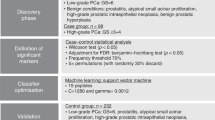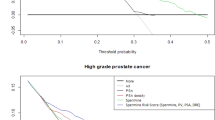Abstract
Controversial data on sarcosine as a promising biomarker for prostate cancer (PCa) detection are present. The objective was to clarify these discrepancies and reevaluate the potential value of sarcosine in PCa. Sarcosine algorithms (supernatant and sediment sarcosine/creatinine, supernatant and sediment log2 (sarcosine/alanine)) in urine samples from 71 untreated patients with PCa, 39 patients with no evidence of malignancy (NEM) and 20 healthy women and men were quantified by liquid chromatography/tandem mass spectrometry. Although any sarcosine algorithms were significantly higher in PCa patients than in NEM patients (all P<0.05), comparable sarcosine values were measured in healthy women and men. Additionally, neither biopsy Gleason score nor clinical T-stage were correlated with sarcosine algorithms (all P>0.05), and receiver operating characteristic curve analysis indicated that the diagnostic power of any of sarcosine algorithms was nonsignificantly higher than that of serum and urine PSA, but nonsignificantly lower than prostate cancer antigen 3 (PCA3) and the percent-free PSA (%fPSA). Improved diagnostic performances were observed when any of sarcosine algorithms was combined with PCA3 or %fPSA. In conclusion, the predictive power of sarcosine in PCa is modest compared with PCA3 and %fPSA. Sarcosine, which awaits more validation before it reaches the clinic, could be included into the list of candidate PCa biomarkers.
This is a preview of subscription content, access via your institution
Access options
Subscribe to this journal
Receive 4 print issues and online access
$259.00 per year
only $64.75 per issue
Buy this article
- Purchase on Springer Link
- Instant access to full article PDF
Prices may be subject to local taxes which are calculated during checkout

Similar content being viewed by others
References
Jemal A, Siegel R, Ward E, Hao Y, Xu J, Thun MJ . Cancer statistics, 2009. CA Cancer J Clin 2009; 59: 225–249.
Sim HG, Cheng CW . Changing demography of prostate cancer in Asia. Eur J Cancer 2005; 41: 834–845.
Spratlin JL, Serkova NJ, Eckhardt SG . Clinical applications of metabolomics in oncology: a review. Clin Cancer Res 2009; 15: 431–440.
Griffin JL, Shockcor JP . Metabolic profiles of cancer cells. Nat Rev Cancer 2004; 4: 551–561.
Chen Y, Zhang R, Song Y, He J, Sun J, Bai J et al. RRLC-MS/MS-based metabonomics combined with in-depth analysis of metabolic correlation network: finding potential biomarkers for breast cancer. Analyst 2009; 134: 2003–2011.
Kim K, Aronov P, Zakharkin SO, Anderson D, Perroud B, Thompson IM et al. Urine metabolomics analysis for kidney cancer detection and biomarker discovery. Mol Cell Proteomics 2009; 8: 558–570.
Osl M, Dreiseitl S, Pfeifer B, Weinberger K, Klocker H, Bartsch G et al. A new rule-based algorithm for identifying metabolic markers in prostate cancer using tandem mass spectrometry. Bioinformatics 2008; 24: 2908–2914.
Sreekumar A, Poisson LM, Rajendiran TM, Khan AP, Cao Q, Yu J et al. Metabolomic profiles delineate potential role for sarcosine in prostate cancer progression. Nature 2009; 457: 910–914.
Jentzmik F, Stephan C, Miller K, Schrader M, Erbersdobler A, Kristiansen G et al. Sarcosine in urine after digital rectal examination fails as a marker in prostate cancer detection and identification of aggressive tumours. Eur Urol 2010; 58: 12–18, 20-21.
Schalken JA . Is urinary sarcosine useful to identify patients with significant prostate cancer? The trials and tribulations of biomarker development. Eur Urol 2010; 58: 19–20.
Stephan C, Jentzmik F, Jung K . Reply from authors re: Jack A Schalken. Is urinary sarcosine useful to identify patients with significant prostate cancer? the trials and tribulations of biomarker development. Eur Urol 2010; 58: 20–21.
Sreekumar A, Poisson LM, Rajendiran TM, Khan AP, Cao Q, Yu J et al. Re: Florian Jentzmik, Carsten Stephan, Kurt Miller, et al. Sarcosine in urine after digital rectal examination fails as a marker in prostate cancer detection and identification of aggressive tumours. Eur Urol 2010; 58: e29–e30.
Jentzmik F, Stephan C, Jung K . Reply to Arun Sreekumar, Laila M Poisson, Thekkelnaycke M. Rajendiran, et al.'s Letter to the Editor re: Florian Jentzmik, Carsten Stephan, Kurt Miller, et al. Sarcosine in Urine after Digital Rectal Examination Fails as a Marker in Prostate Cancer Detection and Identification of Aggressive Tumours. Eur Urol 2010; 58: e31–e32.
Hewavitharana AK . Re: Florian Jentzmik, Carsten Stephan, Kurt Miller, et al. Sarcosine in urine after digital rectal examination fails as a marker in prostate cancer detection and identification of aggressive tumours. Eur Urol 2010; 58: e39–e40.
Jentzmik F, Stephan C, Jung K . Reply to Amitha K Hewavitharana's Letter to the Editor re: Florian Jentzmik, Carsten Stephan, Kurt Miller, et al. Sarcosine in urine after digital examination fails as a marker in prostate cancer detection and identification of aggressive tumours. Eur Urol 2010; 58: 12–18. Eur Urol 2010; 58: e41–e42.
Colleselli D, Stenzl A, Schwentner C . Re: Florian Jentzmik, Carsten Stephan, Kurt Miller, et al. Sarcosine in urine after digital rectal examination fails as a marker in prostate cancer detection and identification of aggressive tumours. Eur Urol 2010; 58: 12–28, 2010; 58: e51.
Groskopf J, Aubin SM, Deras IL, Blase A, Bodrug S, Clark C et al. APTIMA PCA3 molecular urine test: development of a method to aid in the diagnosis of prostate cancer. Clin Chem 2006; 52: 1089–1095.
Cao DL, Ye DW, Zhang HL, Zhu Y, Wang YX, Yao XD . A multiplex model of combining gene-based, protein-based and metabolite-based with positive and negative markers in urine for the early diagnosis of prostate cancer. Prostate 2010; e-pub ahead of print 18 October 2010; doi:10.1002/pros.21286.
Mendes P, Kell DB, Westerhoff HV . Why and when channelling can decrease pool size at constant net flux in a simple dynamic channel. Biochim Biophys Acta 1996; 1289: 175–186.
Mendes P, Kell DB, Westerhoff HV . Channelling can decrease pool size. Eur J Biochem 1992; 204: 257–266.
Swanson MG, Zektzer AS, Tabatabai ZL, Simko J, Jarso S, Keshari KR et al. Quantitative analysis of prostate metabolites using 1H HR-MAS spectroscopy. Magn Reson Med 2006; 55: 1257–1264.
Kline EE, Treat EG, Averna TA, Davis MS, Smith AY, Sillerud LO . Citrate concentrations in human seminal fluid and expressed prostatic fluid determined via 1H nuclear magnetic resonance spectroscopy outperform prostate specific antigen in prostate cancer detection. J Urol 2006; 176: 2274–2279.
Serkova NJ, Spratlin JL, Eckhardt SG . NMR-based metabolomics: translational application and treatment of cancer. Curr Opin Mol Ther 2007; 9: 572–585.
Mitchell AD, Benevenga NJ . Importance of sarcosine formation in methionine methyl carbon oxidation in the rat. J Nutr 1976; 106: 1702–1713.
Mudd SH, Brosnan JT, Brosnan ME, Jacobs RL, Stabler SP, Allen RH et al. Methyl balance and transmethylation fluxes in humans. Am J Clin Nutr 2007; 85: 19–25.
Acknowledgements
We thank Jun Qian from our Cancer Center (Phase I clinical laboratory), Yu-Hu Xin and Yue Cao from our Cancer Center (Department of Laboratory) and Yan Huang from our Cancer Center (Department of Gynecology) for providing technical assistance. This study was supported by the Shanghai Charitable Cancer Research Center; Grant no. Shaz200908.
Author information
Authors and Affiliations
Corresponding author
Ethics declarations
Competing interests
The authors declare no conflict of interest.
Additional information
Supplementary Information accompanies the paper on the Prostate Cancer and Prostatic Diseases website
Rights and permissions
About this article
Cite this article
Cao, DL., Ye, DW., Zhu, Y. et al. Efforts to resolve the contradictions in early diagnosis of prostate cancer: a comparison of different algorithms of sarcosine in urine. Prostate Cancer Prostatic Dis 14, 166–172 (2011). https://doi.org/10.1038/pcan.2011.2
Received:
Revised:
Accepted:
Published:
Issue Date:
DOI: https://doi.org/10.1038/pcan.2011.2
Keywords
This article is cited by
-
Programming bulk enzyme heterojunctions for biosensor development with tetrahedral DNA framework
Nature Communications (2020)
-
Reliable identification of prostate cancer using mass spectrometry metabolomic imaging in needle core biopsies
Laboratory Investigation (2019)
-
Approaches to urinary detection of prostate cancer
Prostate Cancer and Prostatic Diseases (2019)
-
Metabolomic and BH3 profiling of esophageal cancers: novel assessment methods for precision therapy
BMC Gastroenterology (2018)
-
Prostate tumor attenuation in the nu/nu murine model due to anti-sarcosine antibodies in folate-targeted liposomes
Scientific Reports (2016)



